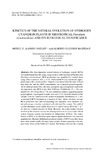| dc.description.abstract | Kinetics of the natural evolution of hydrogen cyanide in plants in neotropical Pteridium Arachnoideum and its ecological significance
(Alonso Amelot, Miguel and Oliveros, Alberto)
Abstract
The time-dependent natural release of hydrogen cyanide (HCN) was studied quantitatively using young croziers of the neotropical bracken fern Pteridium arachnoideum. HCN production was quantified in crushed tissue using a flow reactor at 30.0 ± 0.1?C. Released HCN was carried into appropriate traps with a moist air flow. Aliquots were drawn from the traps at fixed time intervals, and the HCN concentration was evaluated spectroscopically. All available prunasin (Pru), the only cyanogenic glycoside present, underwent decomposition into HCN in less than 1200 min. Fiddleheads (N = 76) contained 1.84-107.70 mg Pru g-1 dw in a continuous fashion suggesting genetic polymorphism. Acyanogenic morphs were rare (1/77). From the kinetics of the samples with Pru content near the median histographic distribution (N = 46), accumulated HCN formation as a function of time, initial velocities, average HCN production rate, and corresponding rate equations were obtained. Initial and average velocities correlated well with total Pru content. The yield of cyanide liberation varied widely between 0.51 and 47.86 µg HCN min-1 g-1 dw and was a linear function of [Pru]t. However, the ß-glucosidase enzyme involved in this reaction was not rate limiting and occurs in excess in the natural system. Enzyme activity was found to be independent of [Pru]t . The contribution of HCN as an allomone-upon-request against herbivores was assessed quantitatively. Bracken fiddleheads produced a pulse of HCN soon after tissue injury that waned rapidly, leaving a large portion of intact prunasin to decompose more slowly in the herbivore's lumen. The balance between the external and internal courses was found to depend on the concentration of prunasin in the plant, the amount of crozier eaten, and the time used to consume it.
Journal of Chemical Ecology, Vol. 31, No. 2, February 2005 (©2005) DOI: 10.1007/s10886-005-1343-z | es_VE |


